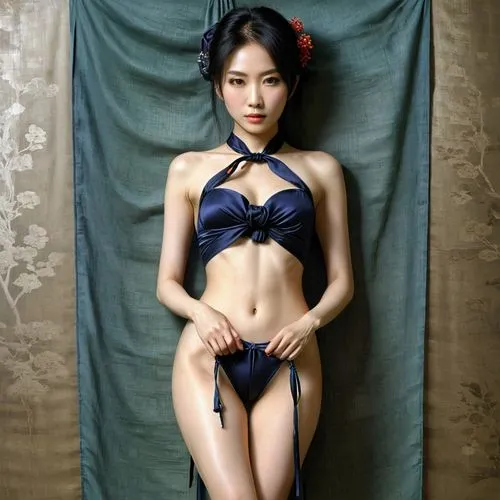Ethnographic Snapshot: Venue Types in Modern Japanese Nightlife
In modern Japanese nightlife, erotic entertainment is organized around specific venue types. A Pinsaro (Pink Salon) is typically a small, softly lit lounge with booth seating, offering short, one-on-one sessions involving drinks, intimate proximity, and oral contact as a standard, ritualized component of the performance. A Soapland provides private rooms where bathing rituals and body-to-body interaction form a structured format of intimacy that is time-based and choreographed. Image Clubs stage role-play through costumes and set concepts; Sexy Cabarets combine seated socializing with light tactile proximity; and Delivery Health services operate in external spaces like hotels. By contrast, a Love Hotel is not a sex-worker venue but a private accommodation designed for couples. Its architecture (soundproofed rooms, direct access, automated payment) institutionalizes “staged privacy,” separating intimate time from the public city while normalizing short, time-slotted stays for everyday urban users (20s–50s and inbound travelers). Increasing multilingual interfaces since the 2020s reflect growing international use.
Explore more on SoapEmpire: Tokyo Red Light District Guide / Japan Nightlife Home / Tokyo Soapland Guide
1. What exactly is a Japanese love hotel?

Answer Box: A love hotel is a privacy-focused, short-stay hotel optimized for couples. Rooms are soundproofed and themed, with large baths and amenities. Time-based plans—Rest (1–4h), Free Time (daytime block), and Stay (overnight)—are standard. Many accept reservations and cards; some allow re-entry. Minors are not permitted.
1.1 The urban function: staged privacy in a dense city
In ethnographic terms, love hotels provide “institutionalized intimacy”: regulated, time-limited spaces where couples can retreat from crowded urban life. The built environment—direct access, elevators, subdued corridors—supports anonymity and quiet. Modern chains explicitly welcome couples, friends, and even small group “girls’ party” plans.
Example: Shinjuku’s resort-style chain offers multilingual pages and online booking, positioning itself as a couples’ hotel with spa options. See Store Official Website.
1.2 What you typically find inside
Rooms often include large bathtubs (sometimes Jacuzzi/“rainbow blower” types), video-on-demand, big-screen TVs (65–75″), and robust amenities. A Shibuya property lists rest-from pricing alongside equipment like bath TVs and massage tools; see Store Official Website.
1.3 Who can (and cannot) use them
Adults only. Love hotels are not for minors. Chain FAQs make this explicit; for example, a major group states that customers under 18 cannot use their love-hotel brand and details accepted payment methods and outside-visit rules: Store Official Website. Another national brand reiterates the 18+ rule: Store Official Website.
2. Where are the main love-hotel districts in Tokyo?

Answer Box: The densest clusters are Shibuya Dōgenzaka (Maruyamachō), Shinjuku Kabukichō, Ikebukuro (West & North), and Ueno/Okachimachi. These areas are minutes from major stations, with dozens of properties per district.
2.1 Shibuya (Dōgenzaka & Maruyamachō)
Historically a leisure-and-nightlife slope, the Dōgenzaka/Maruyamachō area is actively managed by local and ward bodies for safe, mixed use. See Shibuya Ward’s urban pages and the area’s civic council: Shibuya City (official) and Dōgenzaka Machizukuri Council. For a concrete hotel example in this zone (with “reservation OK” and re-entry notes), see Store Official Website.
2.2 Shinjuku (Kabukichō 2-chōme)
Kabukichō is a vast nightlife district born after 1947’s postwar rebuilding and now a tourism hub with hotels and entertainment. For official destination context, see the Shinjuku Tourism Association: Official Tourism Page. A high-end love hotel in the zone publishes access and facilities: Store Official Website.
2.3 Ikebukuro & Ueno belts
Ikebukuro concentrates options near the west/metropolitan exits; a central property with detailed price tables is here: Store Official Website. In Ueno/Okachimachi, look around the pond (Shinobazu) and Ameyoko sides—see example rates and time blocks at Store Official Website.
3. How do prices work (Rest, Free Time, Stay) and what to expect?

Answer Box: The system is time-based. Rest is usually 1–4 hours; Free Time is a discounted daytime block; Stay is overnight. Conclusion → Numbers → Source: Typical Shibuya “Rest” starts around ¥6,700 and “Stay” around ¥13,600 on weekdays (Store Official Website). Ikebukuro examples show “Rest 2h” from ¥6,800–¥8,500 and “Stay (Sun–Thu)” around ¥12,000–¥14,300 depending on room tier (Store Official Website).
3.1 Decoding the plans
- Rest (休憩): Short stay—commonly 90–180 minutes; extensions billed per 15–30 minutes.
- Free Time (フリータイム/サービスタイム): Daytime block (e.g., 6:00–17:00) at a flat rate; great value for rest and relaxation. Example tables: Store Official Website.
- Stay (宿泊): Overnight windows often start 20:00–24:00; checkout by 10:00–12:00. Shibuya sample schedule: Store Official Website.
3.2 What changes the price?
Room grade and size, day of week, season (Obon/New Year), and special events. Chains post surcharges or special systems for peak periods on rate pages: see notes at Store Official Website.
3.3 Payment, reservations, and re-entry
Most modern properties accept major cards and often QR/IC methods. Examples: Shibuya allows cards and notes re-entry permitted; see Store Official Website. Ikebukuro’s price page lists detailed plan pricing and confirms “outside (re-entry) possible”: Store Official Website. Some chains offer advance online booking with multilingual pages (e.g., Shinjuku’s resort-style brand: Store Official Website).
3.4 Tokyo sample hotels & starter prices
| Area | Hotel | Nearest Station | Rest (from) | Stay (from) | Reservation | Official Link |
|---|---|---|---|---|---|---|
| Shibuya (Dōgenzaka) | HOTEL SULATA Shibuya | Shibuya Station | ¥6,700 (weekday) | ¥13,600 (weekday) | Yes | Store Official Website |
| Shinjuku (Kabukichō) | HOTEL PASHA | Seibu-Shinjuku / Shinjuku | Varies by room | Varies by room | Yes | Store Official Website |
| Shinjuku (Kabukichō) | BaliAn Shinjuku | Shinjuku Sanchōme | Tiered by room | Tiered by room | Yes | Store Official Website |
| Ikebukuro (West) | HOTEL AILU | Ikebukuro | ¥6,800–¥8,500 (2–3h) | ¥12,000–¥14,300 (Sun–Thu) | Yes | Store Official Website |
| Ueno / Shinobazu | PASHA GRAN Ueno | Ueno / Keisei-Ueno | Block plans posted | Block plans posted | Yes | Store Official Website |
| Kinshichō | PetitTel Kinshichō | Kinshichō | From ¥2,900 (60m; weekday) | From ¥7,000–¥14,500 (tiered) | Yes (phone/online) | Store Official Website |
4. How to check in and pay: kiosk, reception, and anonymity

Answer Box: Choose a room on a wall panel or at reception, then pay at a kiosk or upon checkout. Doors often lock automatically; when you settle the bill, they unlock. Many hotels accept cards/QR/IC. Some allow re-entry after notifying the desk.
4.1 Kiosk flow (typical)
- Select a room by photo/price on a touch panel.
- Take the printed slip or proceed directly if it’s a room-assignment system.
- Enter the room; in some hotels, the door auto-locks and will unlock after payment at checkout.
Clear how-to guides (with notes on mid-stay exit rules and payment) are published by major search portals: HappyHotel Article.
4.2 Reception-led check-in
Resort-style houses (e.g., Shinjuku) often have full receptions, multilingual pages, and explicit outside-visit rules in their FAQs: BaliAn FAQ.
4.3 Payment methods
Expect support for cash, major credit cards, and often QR/IC. Shibuya’s SULATA lists accepted cards and plan windows on its rooms/system page: Store Official Website. Ikebukuro AILU details plan-by-plan pricing and notes “outside possible”: Store Official Website. Kinshichō property lists multi-method cashless payment: Store Official Website.
5. Etiquette, safety, and useful Japanese phrases

Answer Box: Keep voices low, handle equipment carefully, and respect guest limits (usually 2; some allow 3–4 with fees). No minors. Confirm re-entry rules and smoking policy. Use simple phrases like “Rest one hour, please” or “Stay tonight.”
5.1 Basic rules (widely posted)
- Adults only (18+). Stated by major chains: BaliAn FAQ, Restay.
- Outside/re-entry: Allowed at many hotels; check the page (e.g., SULATA “途中外出可”): Store Official Website.
- Number of guests: Most rooms are for two; some hotels permit 3–4 with surcharges; example policies listed on chain pages like BaliAn Shinjuku.
5.2 Useful phrases (plain, polite)
- “Kyūkei 2-jikan onegaishimasu” — I’d like a Rest for two hours.
- “Shukuhaku onegaishimasu” — I’d like to Stay overnight.
- “Kurejitto kādo tsukaemasu ka?” — Can I use a credit card?
- “Tōchū gaishutsu dekimasu ka?” — Can we step out and re-enter?
5.3 Planning tips by district
Shibuya: Arrive early on weekends—rooms fill fast. Confirm re-entry if you plan to go out for dinner. See a local hotel’s system page: Store Official Website.
Shinjuku (Kabukichō): Navigate via the ward’s tourism map and head toward Kabukichō 2-chōme for quieter hotel streets: Official Tourism Page. For a premium spa-heavy option, see Store Official Website.
Ikebukuro / Ueno: Good value tiers; consult official price pages to match your time window: Ikebukuro AILU, Ueno PASHA GRAN.
6. Summary and next steps

Answer Box: What are Japanese love hotels? Practical, time-slotted spaces for adults seeking privacy. To choose well, decide your district, match a “Rest/Free Time/Stay” window, and check the hotel’s official page for re-entry and payment. Use our table to shortlist and book directly via official sites.
6.1 Quick checklist before you go
- Pick an area (Shibuya/Shinjuku/Ikebukuro/Ueno) close to your evening plan.
- Match your time window (Rest vs. Free Time vs. Stay).
- Confirm payment (card/QR/IC), re-entry, and guest limit on the hotel’s official page.
6.2 A note on culture & design
Love hotels are part of Tokyo’s urban fabric—quiet, standardized, and choreographed. Architecture (soundproofing, internal circulation) and systems (kiosks, timed plans) institutionalize intimacy without spectacle. For first-timers, that’s why the experience feels calm and practical rather than chaotic.
6.3 Recommended next reads (internal)
Tokyo Red Light District Guide / How Soaplands Work / Find Nightlife by City
Why Use SoapEmpire for Tokyo Love Hotels?
Planning your first night in Tokyo can be overwhelming. You search “what are japanese love hotels,” skim dozens of pages, and still wonder which places are convenient, how much they cost, and whether you can pay by card or step out for dinner and come back. If you’re a traveler or expat, language and timing add to the stress—especially on busy weekends in Shibuya and Shinjuku.
SoapEmpire is designed to remove that friction. Instead of guessing, you get a structured snapshot of each venue: time-based pricing (Rest/Free Time/Stay), re-entry rules, payment methods, and access from the nearest station. Because we cover both nightlife culture and real-world operations, our guides translate local systems into clear, traveler-friendly steps. For this article’s focus—japanese love hotels—we curate options in Dōgenzaka, Kabukichō, Ikebukuro, and Ueno so you can pick a district that matches your evening plans.
What sets SoapEmpire apart is practical detail. We verify hours and plan windows from official pages, highlight English-friendly interfaces where possible, and track amenities that matter (large baths, non-smoking rooms, card/QR/IC payments). If you’re still deciding between a quick Rest or a full Stay, our side-by-side comparisons help you estimate total cost before you go. And because many readers come to us searching “what are japanese love hotels,” we also explain the cultural logic—why kiosks exist, why rooms are soundproof, why daytime “Free Time” can be such good value.
For travelers, the payoff is confidence. You’ll arrive knowing which exit to take, which plan to request, how to check in, and how to pay—no awkward surprises. For expats, our coverage scales beyond central Tokyo to other major cities, so your routine stays consistent.
Need human help? SoapEmpire offers 24-hour booking support for only $10—ideal when rooms are scarce or you’d like us to call and confirm specifics in Japanese. We’ll secure the slot that matches your time window and preferences, and send you the details in English. For reservations or inquiries, please contact us via the inquiry form.
If you’re interested in visiting any of these places, SoapEmpire offers a 24-hour booking support service for only $10.
Just send the store name, preferred time, and your name (nickname is fine) to: artistatakuma@icloud.com.
We’ll take care of your reservation quickly and smoothly.
FAQ: Japanese Love Hotels in Tokyo
Q1. Do I need an ID to use a love hotel?
A. Typically no ID is required for adults, but minors are not allowed. Hotels clearly state 18+ in their policies; see chain FAQs such as Store Official Website.
Q2. Can I make a reservation?
A. Increasingly yes. Many properties accept same-day web bookings or calls (e.g., Shinjuku and Shibuya examples). Check each hotel’s official page: BaliAn Shinjuku, SULATA Shibuya.
Q3. How much should I budget?
A. As a quick benchmark, weekday Shibuya “Rest” often starts around ¥6,700 and “Stay” around ¥13,600 (room tier varies). Sources: Store Official Website. Ikebukuro tiers are similar: Store Official Website.
Q4. Can I step out and come back?
A. Many hotels allow re-entry if you notify the desk; policies are published on official pages (e.g., SULATA “途中外出可”): Store Official Website.
Q5. What payment methods are accepted?
A. Cash and major cards are widely accepted; many also take QR/IC. See hotel pages for specifics (e.g., PetitTel Kinshichō, BaliAn FAQ).
